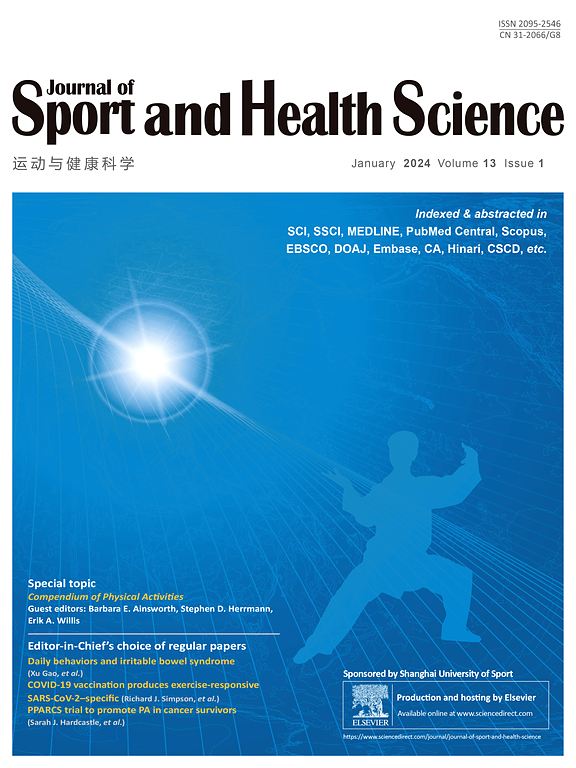Low relative sit-to-stand power is associated with history of falls and fractures, prospective hospitalization, and all-cause mortality in older adults from the Toledo Study for Healthy Aging.
IF 10.3
1区 医学
Q1 HOSPITALITY, LEISURE, SPORT & TOURISM
引用次数: 0
Abstract
BACKGROUND Low relative sit-to-stand (STS) power has emerged as a critical predictor of adverse health outcomes, such as frailty and disability, in older adults. However, its impact on falls, fractures, hospitalizations, and all-cause mortality remains unclear. Therefore, this longitudinal study aimed to investigate the potential associations between low relative STS power and these adverse health outcomes in older adults. METHODS A total of 1876 older adults (aged ≥ 65 years, 56.4% women) were included from the Toledo Study for Healthy Aging. Relative STS power was assessed using the 30-s STS test and the Alcazar equation. Participants were categorized as having low relative STS power based on previously established cut-off points (2.53 W/kg for men and 2.01 W/kg for women). Falls and fractures (hip and all-type) within the previous year were recorded. Hospitalizations and all-cause mortality were obtained during a follow-up of 6.8 ± 3.1 years (mean ± SD; median = 7.8 years; interquartile range: 3.9-10.1 years) and 9.7 ± 3.5 years (median = 10.9 years; interquartile range: 8.2-12.5 years), respectively. Generalized linear mixed models, binary logistic regression, and proportional hazards regression adjusted for age, educational level, and comorbidities were used. RESULTS In men, low relative STS power was significantly associated with an increased likelihood of history of falls (odds ratio (OR) = 1.73, 95% confidence internal (95%CI): 1.08-2.75, p = 0.022) and all-type fractures (OR = 1.86, 95%CI:1.21-2.84, p = 0.004) in the previous year. In women, low relative STS power was associated with a higher probability of hip fractures within the previous year (OR = 3.25, 95%CI: 1.07-9.86, p = 0.038). Low relative STS power predicted hospitalizations in women (hazard ratio (HR) = 1.29, 95%CI: 1.06-1.58, p = 0.012) and longer hospital stays in both men (p = 0.020) and women (p = 0.033). Low relative STS power significantly increased all-cause mortality in both men (HR = 1.57, 95%CI: 1.26-1.97, p < 0.001) and women (HR = 2.04, 95%CI: 1.51-2.74, p < 0.001). CONCLUSION Low relative STS power was associated with history of hip fractures in women, whereas in men it was associated with history of falls and all-type fractures. Low relative STS power predicted hospitalizations in women but not in men. In both men and women, low relative STS power was associated with longer hospital stays and increased risk of all-cause mortality.托莱多健康老龄化研究显示,相对坐立比低与老年人跌倒和骨折史、预期住院和全因死亡率有关。
背景:在老年人中,较低的相对坐立比(STS)功率已成为不良健康结果(如虚弱和残疾)的重要预测指标。然而,它对跌倒、骨折、住院和全因死亡率的影响尚不清楚。因此,本纵向研究旨在调查低相对STS能力与老年人这些不良健康结果之间的潜在关联。方法托莱多健康老龄化研究共纳入1876名老年人(年龄≥65岁,56.4%为女性)。采用30s STS测试和Alcazar方程评估相对STS功率。根据先前建立的分界点(男性2.53 W/kg,女性2.01 W/kg),参与者被归类为具有较低的相对STS功率。记录了前一年的跌倒和骨折(髋部和所有类型)。住院和全因死亡率随访时间为6.8±3.1年(mean±SD; = 平均7.8年;四分位数间距:3.9-10.1年)和9.7±3.5年(中位数 = 10.9年;四分位数间距:8.2-12.5年)。采用广义线性混合模型、二元logistic回归和按年龄、教育水平和合并症调整的比例风险回归。结果在男性中,较低的STS相对功率与前一年跌倒史(比值比(OR) = 1.73,95%置信区间(95% ci): 1.08-2.75, p = 0.022)和所有类型骨折(OR = 1.86,95% ci:1.21-2.84, p = 0.004)的可能性增加显著相关。在女性中,较低的相对STS能力与较高的髋部骨折发生率相关(OR = 3.25,95%CI: 1.07-9.86, p = 0.038)。低相对STS功率预测女性住院(风险比(HR) = 1.29,95%CI: 1.06-1.58, p = 0.012)和男性(p = 0.020)和女性(p = 0.033)住院时间更长。低STS相对功率显著增加了男性(HR = 1.57,95%CI: 1.26-1.97, p < 0.001)和女性(HR = 2.04,95%CI: 1.51-2.74, p < 0.001)的全因死亡率。结论相对STS功率低与女性髋部骨折史相关,而与男性跌倒史和所有类型骨折相关。相对STS功率低可预测女性住院,但对男性无效。在男性和女性中,低相对STS能力与较长的住院时间和全因死亡率风险增加有关。
本文章由计算机程序翻译,如有差异,请以英文原文为准。
求助全文
约1分钟内获得全文
求助全文
来源期刊

Journal of Sport and Health Science
SPORT SCIENCES-
CiteScore
18.30
自引率
1.70%
发文量
101
审稿时长
22 weeks
期刊介绍:
The Journal of Sport and Health Science (JSHS) is an international, multidisciplinary journal that aims to advance the fields of sport, exercise, physical activity, and health sciences. Published by Elsevier B.V. on behalf of Shanghai University of Sport, JSHS is dedicated to promoting original and impactful research, as well as topical reviews, editorials, opinions, and commentary papers.
With a focus on physical and mental health, injury and disease prevention, traditional Chinese exercise, and human performance, JSHS offers a platform for scholars and researchers to share their findings and contribute to the advancement of these fields. Our journal is peer-reviewed, ensuring that all published works meet the highest academic standards.
Supported by a carefully selected international editorial board, JSHS upholds impeccable integrity and provides an efficient publication platform. We invite submissions from scholars and researchers worldwide, and we are committed to disseminating insightful and influential research in the field of sport and health science.
 求助内容:
求助内容: 应助结果提醒方式:
应助结果提醒方式:


